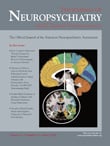Since the introduction of CT basal ganglia calcification has been described in otherwise healthy elderly individuals and in symptomatic patients. This led to an ongoing discussion about significance and relationship between clinical, radiological, or pathological findings in basal ganglia calcifications. Incidence of basal ganglia calcification was reported to be about 6.6 per 1,000 in a screening of CT scans. In most patients calcification was rather small and usually confined to the globus pallidus. In the symptomatic patients the amount of calcification was significantly greater than in asymptomatic patients.
4 Our patient developed parallel parkinsonism and a quite extensive striopallidal calcinosis over 2 years. The simultaneous development of calcifications and clinical symptoms points to a correlation between calcification and parkinsonism, although an influence of long-term antipsychotic treatment cannot be ruled out completely. Drug-induced parkinsonism, however, is in most cases reversible and resolves after the medication is stopped or switched to quetiapine. Tardive dsykinesia is characterized by coordinated, constant movements of the mouth, tongue, jaw, and cheeks. If trunk movements are present, they are typically found in the form of rapid forward motions of the lower abdomen and hips or twisting or flicking movements of the arms and legs. None of this was present. To avoid the misleading name of “Fahr`s disease,” a new classification which considers the whole spectrum of disorders in which basal ganglia calcification can be found was proposed in 2005.
4 Within this classification our case meets criteria for bilateral striopallidal calcinosis. In a recent study about radiological features of Gorlin syndrome 2% of the patients showed basal ganglia calcification.
3 Basal ganglia calcification in Gorlin syndrome has to be considered as a rare feature in a rare disease. In our case calcification occurred at 68 years old. Medium age in the above mentioned study was 35 years old, and these patients were screened only once by MRI or CT. All affected patients were discovered in the CT group. As intracranial calcification is associated with Gorlin syndrome we would recommend using CT and an MRI protocol including susceptibility-weighted MRI sequences (T2*). This combination appears useful in order to visualize calcifications and other potential pathology accountable for the clinical features with high sensitivity.
5 When clinically indicated, follow-up MRI may be very useful in demonstrating the progression of pathological changes. This may provide a background for the understanding of clinical progression and unfavorable response to therapy in
l -dopa-resistant atypical Parkinson’s syndrome.


